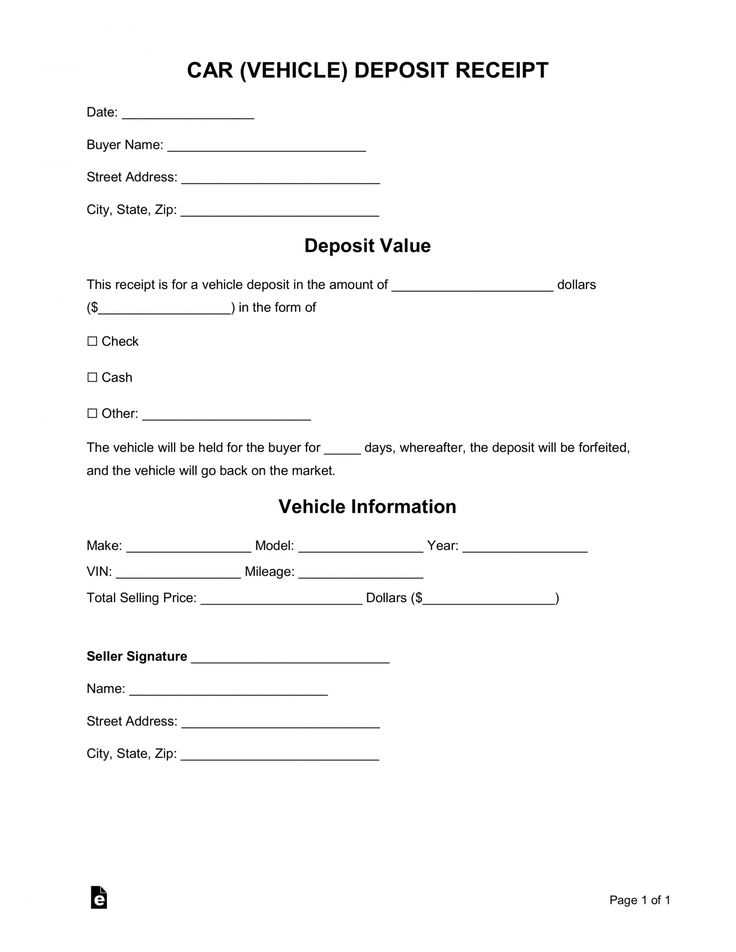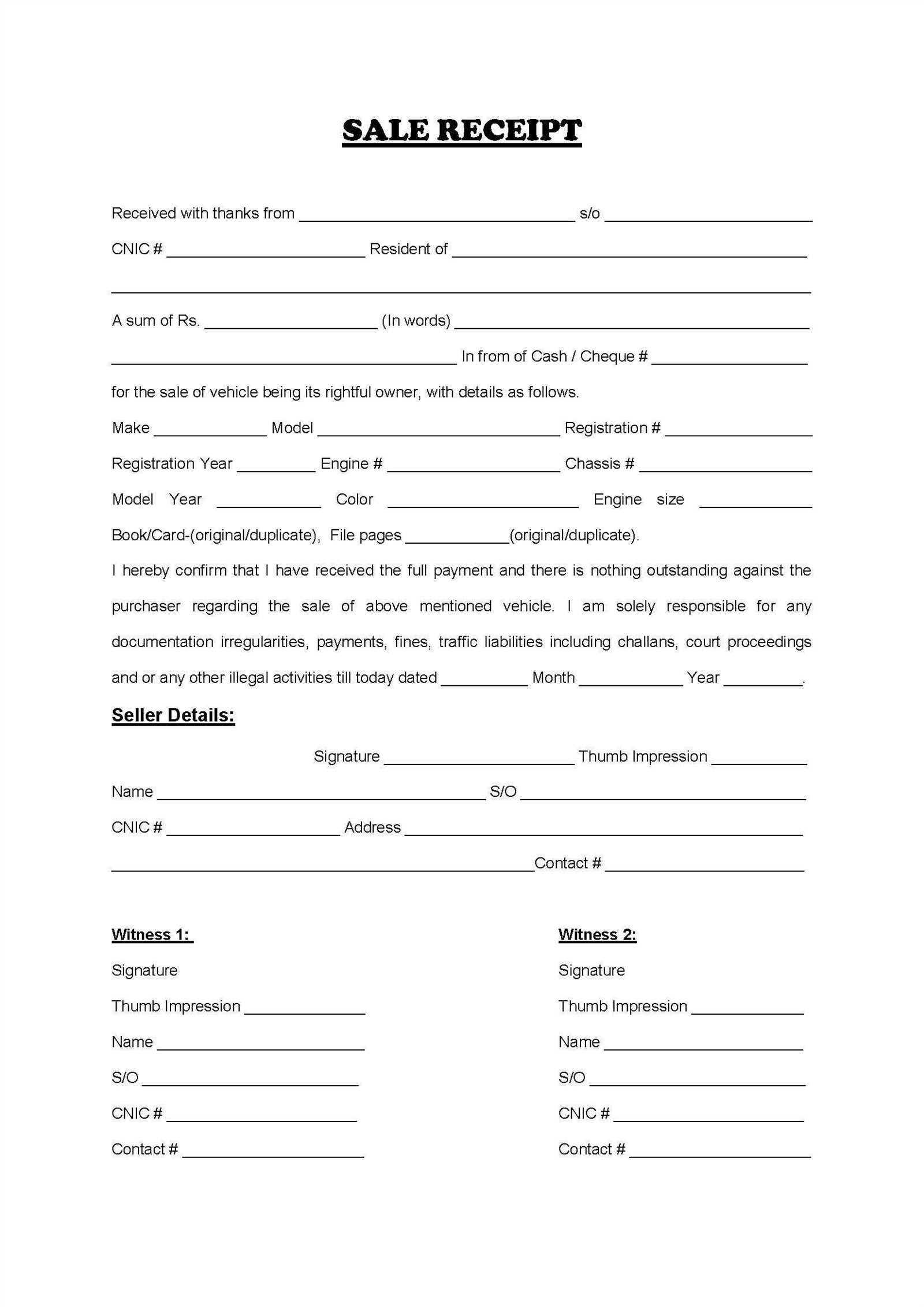
When selling a car privately, always provide a receipt to document the transaction. A well-structured receipt protects both the buyer and the seller by confirming payment, vehicle details, and terms of sale.
Include key details such as the date of sale, names and contact information of both parties, vehicle make, model, year, and VIN, as well as the sale price and payment method. Specify whether the sale is “as-is” to prevent future disputes.
Signatures from both the buyer and seller are essential. A signed document confirms mutual agreement and serves as proof of ownership transfer. Make two copies–one for each party–to ensure both have a record of the transaction.
A clear, concise receipt simplifies the process and prevents misunderstandings. Below, you’ll find a template that covers all necessary details for a legally sound private car sale.
Here’s the revised version without redundant word repetitions:
A private car sale requires a well-documented receipt to protect both buyer and seller. Below is a structured template covering all essential details.
| Private Car Sale Receipt | |
|---|---|
| Date of Sale: | [Insert Date] |
| Seller’s Name: | [Full Name] |
| Seller’s Address: | [Street, City, ZIP] |
| Buyer’s Name: | [Full Name] |
| Buyer’s Address: | [Street, City, ZIP] |
| Vehicle Details: | Make: [Brand] | Model: [Model] | Year: [Year] | VIN: [Vehicle Identification Number] | Mileage: [Odometer Reading] |
| Sale Price: | [Amount] [Currency] |
| Payment Method: | [Cash/Bank Transfer/Other] |
| Sold As-Is: | The vehicle is sold in its current condition without warranties. |
| Seller’s Signature: | ______________________ |
| Buyer’s Signature: | ______________________ |
Both parties should keep a signed copy for their records.
- Private Sale of Car Receipt Template
A private car sale receipt serves as proof of transaction between the buyer and seller. It must include essential details to ensure legal clarity and prevent disputes.
Key Information to Include

- Buyer and Seller Details: Full names, addresses, and contact information.
- Vehicle Information: Make, model, year, VIN, mileage, and license plate number.
- Sale Price and Payment Method: Clearly state the agreed price and how payment was made.
- Date and Time of Sale: Specify the exact moment ownership transfers.
- “As-Is” Clause: If applicable, include a statement confirming the buyer accepts the car without warranties.
Sample Receipt Format

To keep it simple, structure the receipt as follows:
Private Car Sale Receipt Seller: [Full Name] Buyer: [Full Name] Vehicle: [Make, Model, Year, VIN] Mileage: [Number] Sale Price: $[Amount] Payment Method: [Cash/Bank Transfer] Date of Sale: [MM/DD/YYYY] “As-Is” Acknowledgment: [Yes/No] Seller’s Signature: __________ Buyer’s Signature: __________
Both parties should retain a signed copy for records. A notary seal can add an extra layer of security if needed.
A proper private sale receipt protects both buyer and seller, ensuring clear documentation of the transaction. Include the following key details:
1. Vehicle and Sale Information
List the make, model, year, VIN, and mileage of the vehicle. State the sale price, payment method, and date of transfer. Specify if the sale is “as-is” or if any warranties apply.
2. Buyer and Seller Details
Include full names, addresses, and contact information for both parties. Signatures from both the buyer and seller confirm mutual agreement and acknowledgment of the sale terms.
A complete receipt prevents disputes and provides proof of ownership transfer, making it an essential document for private car sales.
Include the full legal names and addresses of both the buyer and the seller. Use their official identification details to prevent disputes.
Clearly state the vehicle’s make, model, year, VIN (Vehicle Identification Number), mileage, and license plate number. These details uniquely identify the car and confirm its condition at the time of sale.
Specify the sale price in both numerical and written form to eliminate any ambiguity. If the payment is made in installments, outline the schedule and terms.
Mention the date and time of the sale. This establishes when ownership is transferred and protects both parties in case of future claims.
Include a statement confirming that the vehicle is sold “as-is” unless a warranty or guarantee is explicitly provided. If any conditions apply, describe them in detail.
Both parties must sign and date the receipt. Handwritten signatures add legal weight. If possible, have the document notarized for additional security.
Provide copies of the receipt to both the buyer and the seller. Digital copies can be useful, but physical copies should always be retained.
- Leaving Out Essential Details
Always include the buyer’s and seller’s full names, the date of sale, the vehicle identification number (VIN), make, model, year, sale price, and payment method. Missing any of these can create legal issues or disputes.
- Failing to Specify “As-Is” Condition
If the car is sold without a warranty, state this clearly. A phrase like “Sold as-is, no warranties expressed or implied” prevents future claims about the vehicle’s condition.
- Not Including a Payment Confirmation
Clearly state whether the payment was made in full or if a deposit was given. If a deposit is involved, outline the remaining balance and the due date.
- Forgetting a Signature
A receipt without signatures from both parties may be questioned in case of a dispute. Ensure both the buyer and seller sign and date the document.
- Using Vague or Inaccurate Language
Avoid unclear descriptions like “good condition” without specifics. Instead, state objective facts, such as “no known mechanical issues” or “minor scratches on the rear bumper.”
- Ignoring Local Legal Requirements
Some states require additional disclosures, odometer readings, or notarization. Check local regulations to ensure compliance.
For private car sales, both printable and digital receipt options are available to finalize transactions efficiently. Choose the method that best fits your preferences and needs. A printed receipt can be handed over immediately, providing the buyer with a tangible proof of purchase. Make sure the document is clear and contains all the necessary details such as the buyer’s and seller’s names, car information (make, model, VIN), and the sale amount.
On the other hand, digital receipts are becoming increasingly popular due to their convenience and eco-friendliness. You can create a digital receipt using online templates, or simply send a PDF document via email. This method ensures that both parties can access the receipt anytime, from anywhere. If you opt for a digital format, it’s important to include all the key details that would appear on a printed receipt, such as the transaction date and the parties involved.
Both options should meet legal requirements in your area, so be sure to check any specific regulations. Whether you choose a printed or digital version, keep a copy for your records. This guarantees that both the buyer and seller have reliable proof of the transaction.
Request valid government-issued ID from both the buyer and seller. Verify that the names on the IDs match the information in the car’s registration documents. Cross-check the Vehicle Identification Number (VIN) on the car with the one listed in the title and registration documents to ensure they align.
Confirm the buyer’s contact information and address. It’s helpful to verify these details using online databases or official records. If the seller has listed the car under a different name, ask for proof of ownership and ensure no liens or unpaid loans exist on the vehicle.
Consider using a vehicle history report to check for accidents, mileage discrepancies, and other issues. For further security, require that the payment method be traceable, such as through a bank transfer or certified check. Avoid cash transactions to minimize the risk of fraud.
Trust your instincts–if something feels off, take the time to ask for more information or walk away from the deal. Ensure that both parties are clear on the transaction details and all paperwork is correct before completing the sale.
When selling a car privately, ensuring that your receipt complies with state-specific requirements is crucial. Each state has unique rules about what must be included on a bill of sale to protect both the buyer and the seller. Understanding these regulations will help avoid legal issues down the line.
State-Specific Details to Include

- Buyer and Seller Information: Most states require full names, addresses, and contact details for both parties involved in the transaction. This helps ensure proper documentation in case of future disputes.
- Vehicle Identification Number (VIN): The VIN must be accurately listed on the receipt, as it uniquely identifies the car being sold.
- Sale Price and Date: Clearly state the agreed sale price and the date the transaction took place. Some states also require you to note the form of payment (e.g., cash, check, or bank transfer).
- Odometer Disclosure: Certain states require sellers to disclose the car’s mileage at the time of sale. Failure to do so could lead to penalties if the odometer reading is disputed later.
- Signatures: Both parties should sign the receipt to confirm that the transaction has occurred. Some states may also require notarization to make the document legally binding.
Other Legal Requirements to Keep in Mind

- Taxes: Depending on your state, you may need to report the sale for tax purposes. Some states require a sales tax payment at the time of sale, while others may exempt private sales.
- Title Transfer: A bill of sale is not a title transfer. Ensure that the title of the vehicle is properly signed over to the buyer, as this is required in many states to complete the transaction legally.
- Warranty Disclaimers: Many states require sellers to include a warranty disclaimer stating that the car is sold “as is.” Be sure to check local laws to see if such a statement is necessary.
Meaning Retained, with Reduced Repetition of “Car,” “Sale,” and “Receipt”
To create a clear and concise private sale document, focus on minimizing repetition while retaining necessary details. Avoid using the terms “car,” “sale,” and “receipt” too often by rephrasing where possible. For example, instead of repeating “car sale receipt,” you can refer to it as “transaction record” or “payment proof.” This not only reduces redundancy but also keeps the document professional and easy to read.
Key Elements to Include
Make sure to include the date of the transaction, the amount paid, and the buyer’s and seller’s information. Also, note the condition of the vehicle and any terms agreed upon. Avoid excessive use of the word “car” by describing the vehicle with specific details such as make, model, and year. This adds clarity without overusing common terms.
Structuring the Document
Keep the format simple: start with the buyer and seller details, followed by the description of the item being sold. Include the agreed price, payment method, and the signature of both parties. Using clear headings and bullet points can also help to organize the information in an easy-to-follow manner.


